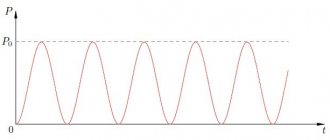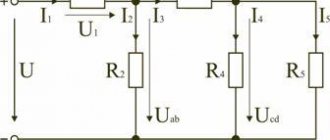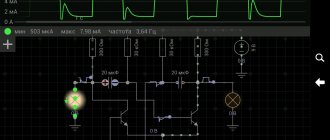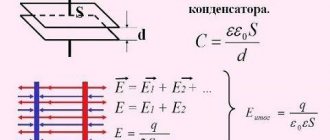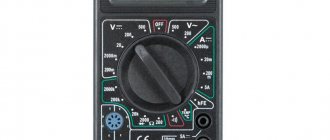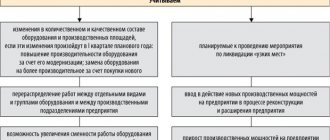In nature, there are two main types of materials, conductive and non-conducting (dielectrics). These materials differ in the presence of conditions for the movement of electric current (electrons) in them.
Electrical conductors are made from conductive materials (copper, aluminum, graphite, and many others), in which electrons are not bound and can move freely.
In dielectrics, electrons are tightly bound to atoms, so current cannot flow in them. They are used to make insulation for wires and parts of electrical appliances.
In order for electrons to begin to move in a conductor (current flows through a section of the circuit), they need to create conditions. To do this, there must be an excess of electrons at the beginning of the chain section, and a deficiency at the end. To create such conditions, voltage sources are used - accumulators, batteries, power plants.
For AC
However, for an AC electrical circuit, it is necessary to take into account the apparent, active and reactive, as well as power factor (cosF). We discussed all these concepts in more detail in this article: https://samelectrik.ru/chto-takoe-aktivnaya-reaktivnaya-i-polnaya-moshhnost.html.
We only note that in order to find the total power in a single-phase network by current and voltage, you need to multiply them:
S=UI
The result will be obtained in volt-amperes; to determine the active power (watts), you need to multiply S by the coefficient cosФ. It can be found in the technical documentation for the device.
P=UIcosФ
To determine reactive power (reactive volt-amperes), sinФ is used instead of cosФ.
Q=UIsinФ
Or express from this expression:
And from here calculate the required value.
Finding the power in a three-phase network is also easy; to determine S (total), use the calculation formula for current and phase voltage:
And knowing Ulinear:
1.73 or root of 3 - this value is used for calculations of three-phase circuits.
Then, by analogy, to find P active:
You can determine reactive power:
This is where the theoretical information ends and we move on to practice.
Power standards in the AC network
Voltage and power are what every person living in an apartment or private house needs to know. The standard AC voltage in an apartment and a private house is expressed as 220 and 380 watts. As for determining the quantitative measure of the strength of electrical energy, it is necessary to add the electric current with the voltage or measure the required indicator with a wattmeter. At the same time, in order to take measurements with the last device, you need to use probes and special programs.
What is AC Power
AC power is determined by the relationship of the amount of current with time, which produces work in a certain time. An ordinary user uses the power indicator transmitted to him by the electrical energy supplier. As a rule, it is equal to 5-12 kilowatts. These figures are enough to ensure the functionality of the necessary household electrical equipment.
This indicator depends on the external conditions for the supply of energy to the house, what current-limiting devices are installed (automatic or semi-automatic) that regulate the moment the power tanks enter the consumer source. This occurs at different levels, from the household electrical panel to the central electrical distribution unit.
Power standards in the AC network
For AC
However, for an AC electrical circuit, it is necessary to take into account the apparent, active and reactive, as well as power factor (cosF). We discussed all these concepts in more detail in this article: https://samelectrik.ru/chto-takoe-aktivnaya-reaktivnaya-i-polnaya-moshhnost.html.
We only note that in order to find the total power in a single-phase network by current and voltage, you need to multiply them:
S=UI
The result will be obtained in volt-amperes; to determine the active power (watts), you need to multiply S by the coefficient cosФ. It can be found in the technical documentation for the device.
P=UIcosФ
To determine reactive power (reactive volt-amperes), sinФ is used instead of cosФ.
Q=UIsinФ
Or express from this expression:
And from here calculate the required value.
Finding the power in a three-phase network is also easy; to determine S (total), use the calculation formula for current and phase voltage:
S=3Uph/ph
And knowing Ulinear:
S=1.73*UлIл
1.73 or root of 3 - this value is used for calculations of three-phase circuits.
Then, by analogy, to find P active:
P=3Uф/ф*cosФ=1.73*UлIл*cosФ
You can determine reactive power:
Q=3Uф/ф*sinФ=1.73*UлIл*sinФ
This is where the theoretical information ends and we move on to practice.
How to save money
Installing a two-tariff meter allows you to save on heating costs with electricity. Moscow tariffs for apartments and houses equipped with stationary electric heating systems distinguish between two prices:
- 4.65 RUR from 7:00 to 23:00.
- 1.26 rubles from 23:00 to 7:00.
Then you will spend, subject to round-the-clock operation of a 9 kW electric boiler turned on at one third of the power:
9*0.3*12*4.65 + 9*0.3*12*1.26 = 150 + 40 = 190 rubles
The difference in daily consumption is 80 rubles. You will save 2400 rubles per month. Which justifies the installation of a two-tariff meter.
The second way to save when using a two-tariff meter is to use automatic control devices for electrical appliances. The idea is to place the peak consumption of an electric boiler, boiler, etc. at night, then most of the electricity will be charged at 1.26, not 4.65. While you are at work, the boiler can either turn off completely or operate in a reduced energy consumption mode, for example at 10% of power. To automate the operation of an electric boiler, you can use programmable digital thermostats or boilers with programming capabilities.
In conclusion, I would like to note that heating a house with electricity is quite an expensive method, regardless of the specific method, be it an electric boiler, convector or other electric heater. People come to him only in cases where there is no way to connect to gas. In addition to the costs of operating an electric boiler, you will also face the initial costs of arranging for a three-phase electricity supply.
The main troubles are:
- preparation of a package of documents, including technical specifications, electrical design, etc.;
- organization of grounding;
- the cost of cable for connecting the house and installing new wiring;
- installation of the meter.
Moreover, you may be denied three-phase input and an increase in power if there is no such technical possibility in your area, when transformer stations are already operating at the limit. The choice of boiler and heating type depends not only on your desires, but also on the capabilities of the infrastructure.
This is where we end our short article. We hope you now understand what the real electricity consumption of an electric boiler is and how you can reduce the cost of heating your home with electricity.
Number of blocks: 18 | Total number of characters: 24761 Number of donors used: 7 Information on each donor:
- https://samelectrik.ru/skolko-elektroenergii-potreblyaet-elektrokotel.html: 3 blocks out of 5 were used, number of characters 4059 (16%)
- https://otoplenie-gid.ru/kotli/elektricheskiye/845-skolko-potreblyaet-elektricheskij-kotel-otopleniya-v-mesyac: 4 blocks out of 5 were used, number of characters 6749 (27%)
- https://electroadvice.ru/eto-interesno/skolko-potreblyaet-elektricheskij-kotel-otopleniya-v-mesyac/: 2 blocks out of 4 were used, number of characters 2627 (11%)
- https://teplofan.ru/kotly/elektricheskie/skolko-potreblyaet: 1 blocks out of 4 used, number of characters 2016 (8%)
- https://teplospec.com/elektricheskoe-otoplenie/elektricheskiy-kotel-raskhod-elektroenergii-ekonomichnye-raschety.html: 3 blocks out of 5 were used, number of characters 4182 (17%)
- https://ks5.ru/otoplenie/kotly/elektricheskie/skolko-potreblyaet.html: 2 blocks out of 4 used, number of characters 2963 (12%)
- https://sansk.ru/how-much-electricity-does-an-electric-boiler-consume-electric-boiler-electricity-consumption-economical-calculations/: 3 blocks out of 9 used, number of characters 2165 (9 %)
Calculation of electrical circuits
All formulas used to calculate electrical circuits follow from one another.
Electrical characteristics relationships
So, for example, using the formula for calculating power, you can calculate the current strength if P and U are known.
To find out how much current an iron (1100 W) connected to a 220 V network will consume, you need to express the current strength from the power formula:
I = P/U = 1100/220 = 5 A.
Knowing the calculated resistance of the electric stove spiral, you can find P of the device. Power through resistance is determined by the formula:
P = U2/R.
There are several methods that allow you to solve the problems of calculating various parameters of a given circuit.
Methods for calculating electrical circuits
Calculating power for various types of current circuits helps to correctly assess the condition of power lines. Household and industrial devices selected in accordance with the specified parameters Pnom and S will work reliably and withstand maximum loads for years.
Joule-Lenz Law Formula
We have calculated the value of the resistor for making a load block for the computer power supply, but we still need to determine what power the resistor should have? Another law of physics will help here, which was discovered simultaneously by two physicists independently of each other. In 1841 James Joule, and in 1842 Emil Lenz. This law was named after them - the Joule-Lenz Law
.
The power consumed by the load is directly proportional to the applied voltage and the flowing current.
In other words, when the voltage and current change, the power consumption will change proportionally.
where P
is power, measured in watts and denoted by
W
;
U
– voltage, measured in volts and denoted by the letter
B
;
I
– current strength, measured in amperes and denoted by the
letter A.
Knowing the supply voltage and current consumed by an electrical appliance, you can use a formula to determine how much power it consumes. Just enter the data in the boxes below in the online calculator.
| Online calculator to determine power consumption | |
| Voltage, V: | |
| Current strength, A: | |
The Joule-Lenz law also allows you to find out the current consumed by an electrical appliance by knowing its power and supply voltage. The amount of current consumed is necessary, for example, to select the wire cross-section when laying electrical wiring or to calculate the rating.
| Online calculator for determining current strength depending on power consumption | |
| Power consumption, W: | |
| Supply voltage, V: | |
For example, let's calculate the current consumption of a washing machine. According to the passport, the power consumption is 2200 W, the voltage in the household electrical network is 220 V. We substitute the data in the windows of the calculator, we find that the washing machine consumes a current of 10 A.
Another example: you decide to install an additional headlight or sound amplifier in your car. Knowing the power consumption of the installed electrical appliance, it is easy to calculate the current consumption and select the correct wire cross-section for connection to the vehicle's electrical wiring. Let’s say that an additional headlight consumes a power of 100 W (the power of the light bulb installed in the headlight), the on-board voltage of the car network is 12 V. We substitute the power and voltage values in the windows of the calculator, we find that the current consumed will be 8.33 A.
Having understood just two simple formulas, you can easily calculate the currents flowing through the wires, the power consumption of any electrical appliances - you will practically begin to understand the basics of electrical engineering.
Characteristics
Alternating current flows through a circuit and changes its direction with magnitude. Creates a magnetic field. Therefore, it is often called periodic sinusoidal alternating electric current. According to the law of a curved line, its value changes after a specific period of time. That's why it's called sinusoidal. Has its own parameters. The important ones are to indicate the period with frequency, amplitude and instantaneous value.
A period is the time during which the electric current changes, and then it repeats again. Frequency is the period per second. Measured in hertz, kilohertz and millihertz.
Amplitude is the maximum current value with voltage and flow efficiency over a full period. Instantaneous value is an alternating current or voltage that occurs during a specific time.
AC Characteristics
